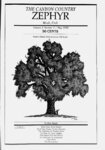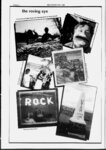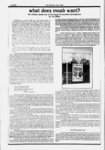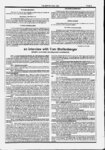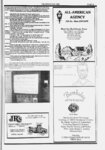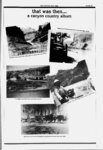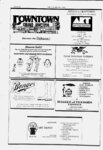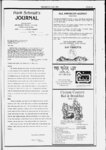| OCR Text |
Show THE ZEPHYR MAY 1990 PAGE 20 from the sierra club PACK CREEK RANCH wilderness economics: boom and bust baloney Lance Christie by In 1986 the Bureau of Land Management (BLM) assessed the economic Impact of BLM concluded designating each Utah Wilderness Study Area as wilderness. The wilderness designation would have little overall economic Impact Modest losses In mineral lease Income would be balanced by modest Increases In local recreational spending. BLMs economic assessment was criticized from both sides. Wilderness opponents portrayed wilderness as bankrupting Southern Utah economies, while some wilderness advocates said positive economic Impacts from wilderness were grossly underestimated. Environmentalist criticism focused on the BLM dropping 1.9 million acres of roadless areas from the Utah wilderness Inventory because these lands supposedly have development potential. Wilderness opponents argued the rest of the 3.2 million acres should be dropped for the same reason. economic argument, Dr. George Learning was hired To support this of to a repeat of his study which found huge losses do Counties Utah Association the by would result from designating BLM lands as wilderness In Arizona. As Dave Knutson said In the Grand County Commission meeting where $1,500 In tax monies was contributed to this study, "We know wilderness Is bad economically, and Dr. Learning will prove It" News reports say Dr. Learning found Utah will lose billions In Income from designating BLM lands as wilderness. The studys sponsors promptly went to the BLM and demanded the BLM revise their economic Impact projections to show wilderness designation would cost billions. We have not been able to get a copy of Dr. Learning's study so we can see what methods were used to obtain these results. The outcome of economic projections such as Dr. Learnings depends entirely on the assumptions one makes. By changing estimates of commodity values present, and future market condtions for commodities and recreation, one could easily produce a study that "proves" wilderness would be an economic bonanza. I think It Is more fun to puzzle out the truth. There have been a number of studies done on the economic Impacts of wilderness on local economies. These have been done by reputable governmental bodies or academic Institutions. They consistently support two conclusions: 1. Adding land to the Wilderness Preservation System has little net economic Impact by Itself. 2. Designated wilderness In an area acts like an advertisement that says: "Here Is a treasurehouse of environmental amenities! And, they'll be here tomorrow because with a bulldozer cant come and tear them up. This "advertising some treasure-hunt- er attracts people economists call "amenity migrants, causing twice the economic growth In rural areas with designated wilderness than In areas without wilderness. Heres a sampling of the Information supporting these conclusions: Governor Bangerter formed a Resource Development Coordinating Committee In 1986 to prepare a comprehensive assessment of wilderness economic Impact on Southern Utah. The Committee established a baseline projection for employment In Southern Utah without wilderness. The Committee concluded that designating two million acres of BLM lands as wilderness would not have significant adverse Impact on commodity Industries, while It would likely Increase employment In trade and service Industries. Mineral lease and school land Income would not be significantly reduced. The report noted, "It Is unlikely that exploration or development would occur In most wilderness study areas (3.2 million acres) even without wilderness designation. The Bangerter study did not deal with the development potential of the 1.9 million acres the BLM dropped from the Inventory. comparison of actual wilderness vs. development values needs to be done In the public debate. This review Is precisely what Wayne Ownens advocates be done for all the areas In his wilderness bill. In 1987, the University of Idaho published a study which compared the growth characteristics of rural counties which contain or are adjacent to federal wilderness, versus the growth of rural counties. The study found: "Counties which contain or are adjacent to a federally designated wilderness are among the fastest growing In the United States." Remote rural wilderness counties grew at twice the rate of The migrants responsible for this growth were younger, highly educated, and In moved to enjoy environmental amenities rather than because of economic opportunities. The report found "The presence of wilderness was a very Important reason why people move to or stay In these counties. Once there, these energetic and educated people developed their own economic opportunities, given the economic growth these counties have enjoyed. Surveys of residents of rural wilderness counties found that nearly all (83-across all counties) thought the nearby wilderness areas were Important to their county and wanted to see them kept closed to development The people In these rural counties who were there before wilderness was designated have apparently come to value the effects of wilderness. Many local elected officials and chambers of commerce have lobbied for the largest wilderness alternative In their area of Idaho, Wyoming, Arizona and New Mexico over the past two years. In their testimony, the officials emphasize the Importance of wilderness to their economic development marketing plans. In summary, there Is nothing magical about designated wilderness that either sucks money out of our pockets, or puts money Into our pockets. Designated wilderness signifies the presence of outstanding environmental amenities to the public mind. If a community uses wilderness amenities as a drawing card, then offers goods and services people want when they come to enjoy local amenities, wilderness can make the people selling those goods and services a lot of money. If the community resents visitors and opposes wilderness for taking away the freedom to go dig holes searching for treasure, then wilderness (or any tourism) wont make them money. The whole economic debate over wilderness tends to distract us from the fact that the major reasons for designating wilderness arise from values. Studfes by Brigham Young University show the majority of people In Utah are willing to trade economic values for wilderness values up to a point The question Is one of the true cost of wilderness: how much In economic values are we actually tracing for wilderness values? The answer from counties with wilderness Is - you can have your wilderness and sat tool anti-wildern- ess Restaurant Open Daily 6 PM 10 PM -- multi-agen- PACKRIVER TRIPS Apr May May May May 7-1- 0 15-1- 8 21-2- 4 25-2- 8 June Jul Sep Sept Sept Sept 18-2- 16-1- Oct 3CFI Grand Gulch Trip Anderson Ranch, Salt Creek Trip Glen and Escalante Canyon (Lake Powell) 30-Ma- y 4-- 1 8 7 9-1- 3 17-2- 0 24-2- 7 12-1- 5 Grand Gulch CJniv of Utah, Grand Gulch Trip Univ of Utah, Elk Ridge Art Workshop Univ of Utah, LaSal & South Mountain Workshop Utah Museum of Natural History, Dark Canyon School, Grand Gulch Trip Utah Museum of Natural History, Grand Gulch CFI Grand Gulch Trip Pack Creek Ranch Writers Workshop CONVERSATION AT PACK CREEK RANCH Apr 28 Nov 22-2- CFI Chip Rawlins Poetry Reading 5 Thanksgiving Poetry Readings WRITERS CONFERENCES Oct Oct 7-1- 5 18-2- 1 Wilkins' Pack Creek Ranch Writers Workshop CFI Desert Writers Workshop at PCR OTHER WORKSHOPS Apr Apr 5-- 8 22-2- 6 Aitchison Photo Workshop at PCR Pack Creek Ranch First Aid Course cy Unlt-by-u- nlt unlt-by-u- nlt non-wlldem- ess non-wlldem- 91 non-econo- Daily Horseback Rides At The Ranch For Information or Reservations Phone (801) 259-550- 5 mk Lance Christie Is Chairman of the Canyonlands Group of the Sierra Club, which has occasional meetings and sporadically publishes a newsletter for everyone Interested In local environmental Issues, whether or not a Sierra Club member. For Information, Call Lance at 259-50- 95 or Jack Campbell at 259-51- 15. |
